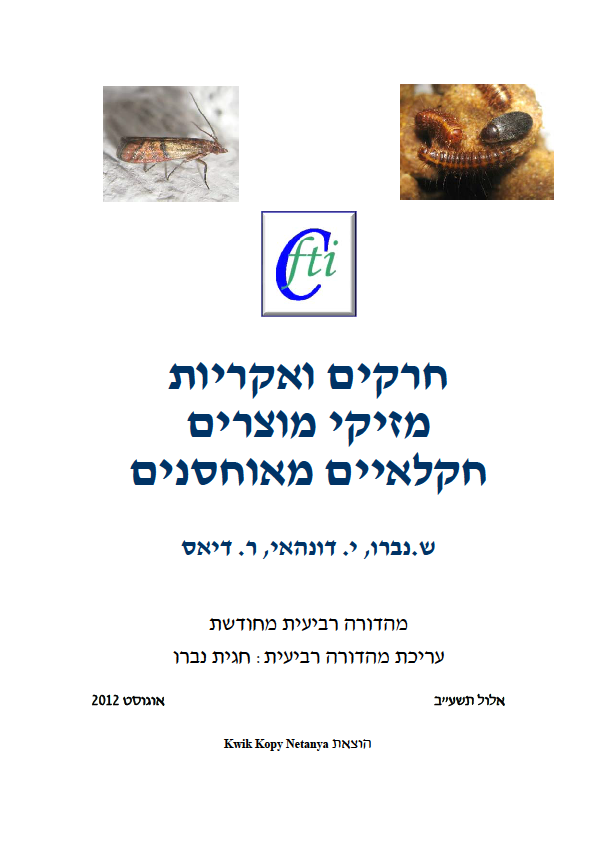פרסומים בספרים של אף.טי.איי.סי.
 חרקים ואקריות מזיקי מוצרים חקלאיים מאוחסנים
חרקים ואקריות מזיקי מוצרים חקלאיים מאוחסנים
שלמה נברו, יונתן דונהאי, רפי דיאס.
מהדורה רביעית מחודשת נערכה על ידי חגית נברו. אלול תשע"ב, אוגוסט 2012.
הימצאות חרקים במזון או במוצרים חקלאיים נחשבת לתופעה בלתי רצויה. מזיקי מחסן מהווים קבוצה ייחודית של חרקים המסוגלים להתפתח בתנאים אקולוגיים השוררים במוצרים חקלאיים מאוחסנים. תנאים אקולוגיים אופייניים הם תנאים קבועים כמעט של יובש או לחות נמוכה. חרקים ואקריות, כאשר נוצרים התנאים לקיומם, מזהמים את מוצרי המזון בעצם נוכחותם, על-ידי נשליהם, הקורים שהם טווים ובהפרשותיהם. יצורים אלה מסוגלים לפגוע במוצרים החקלאיים עוד בשלבי הבשלה בשדה, בשלב כלשהו של הייצור, בעת האחסנה, השיווק ועד לצריכתם. נראה שהשלב החשוב ביותר הוא תקופת האחסנה של המוצרים, מאחר שזאת התקופה האחראית להתפתחות המזיקים, ובשלב מאוחר יותר - כשהמוצר בתהליך העיבוד ועד הצריכה - להימצאותם בתוך המזון. חוברת זו סוקרת את מיניי המזיקים בעלי המשמעות הכלכלית. בהתחשב בנזקים שעלולים לגרום חרקים אלה, חשוב להכיר, ככל האפשר, את תנאי התפתחותם, תפוצתם, אורח חייהם והפונדקאים שלהם. מידע זה חיוני בעיקר לאלה העוסקים בהדברת מזיקים ולאלה העוסקים במזון ובמוצרים חקלאיים מאוחסנים. החוברת כוללת איורים, תמונות ומפתח לזיהוי חרקי המחסן הנפוצים בישראל או בעלי הפוטנציאל להתאקלם בתנאי הארץ.
 Intelligent And Active Packaging For Fruits And Vegetables
Intelligent And Active Packaging For Fruits And Vegetables
Natural Nontoxic Insect Repellent Packaging Materials (chapter 10).
Shlomo Navarro, Dov Zehavi, Sam Ange, and Simcha Finkelman (2007).
In this chapter the reader can explore how natural nontoxic insect repellent plastics can be used to protect packaging against insect attack. The chapter provide information on the "BioPack" repellent product and it use in food packages.
 The Mechanics And Physics Of Modern Grain Aeration Management.
The Mechanics And Physics Of Modern Grain Aeration Management.
Shlomo Navarro and Ronald T. Noyes, (2001)
This book can be used to design and manage aeration systems for all types of grain storage structures in all regions and climatic conditions. It bridges the gap between concepts of the design engineer and the requirements of the postharvest technologist to manipulate the storage ecosystem. It describes alternative, nonstandard aeration practices such as Dryeration, cross-flow aeration, closed loop or recirculation fumigation, and chilled aeration. Not only does The Mechanics and Physics of Modern Grain Aeration Management equips you with the knowledge necessary for aerating properly and efficiently within the context of new regulatory demands and gives you the tools you need to evaluate and test new concepts for assuring stored grain quality.









